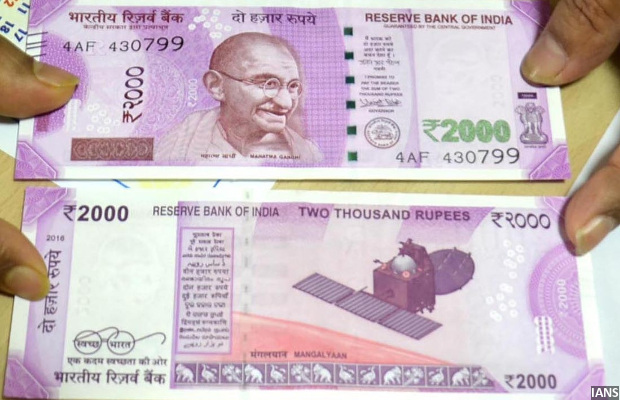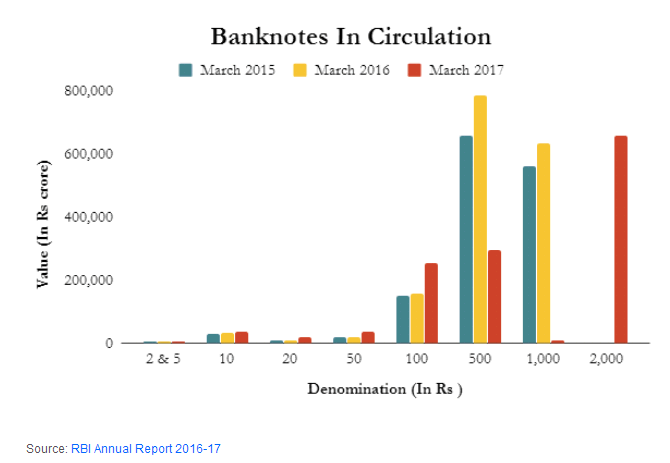The Reserve Bank of India (RBI) spent Rs 7,965 crore on printing currency notes between July 2016 and June 2017, compared to Rs 3,420 crore in 2015-16, an increase of 133%, according to RBI’s annual report 2016-17.

This was highest over the last 17 years, Bloomberg reported on August 30, 2017.
The rise in expenditure was attributed to newly designed notes of higher denominations and the need to replace demonetised currency, the RBI report said. Banknotes were often airlifted from the presses to RBI offices across the country to ensure currency was available after demonetisation, adding to the cost of distribution.
Prime Minister Narendra Modi on November 8, 2016 announced the withdrawal of Rs 500 and Rs 1,000 notes–which constituted 85% of cash in circulation–in a move to fight corruption, black money, money laundering, terrorism and financing of terrorists as well as counterfeit notes, a narrative that kept changing, as IndiaSpend reported on December 5, 2017.
Of Rs 15.44 lakh crore demonetised currency in circulation, about 99% or Rs. 15.28 lakh crore came back to the central bank as on June 30, 2017, the annual report said.
After demonetisation, the Reserve Bank injected 23.8 billion pieces of banknotes into circulation, valued at Rs 5.54 lakh crore, between November 9 and December 31, 2016. About 74% fewer notes were in circulation on March 31, 2017, compared to November 4, 2016.

Circulation of banknotes in terms of value declined by 20% to Rs 13.10 lakh crore ending March 2017, over the preceding year while the volume of notes increased by 11%, due to “higher infusion” of notes of lower denomination, post demonetisation.
The share of Rs 500 and higher denominations stood at 73% of the total value of notes in circulation at end-March 2017, as against 86% at end-March 2016. And, the share of new Rs 2,000 notes was reported 50% at end-March 2017.
Detection of counterfeit notes up 20% in 2016-17, from 6% in 2015-16
In 2016-17, 762,072 counterfeit notes were detected, of which 96% were detected by commercial banks. Detection of counterfeit currency notes by banks increased 20% in 2016-17, of which 42% were old Rs 500 notes.
Similarly, there was a 79% increase in the detection of Rs 1,000 counterfeit currency notes, from 143,099 in 2015-16 to 256,324 in 2016-17.
| Counterfeit Notes Detected in the Banking System, Denomination-wise | |||
|---|---|---|---|
| Denomination (Rs) | 2014-15 | 2015-16 | 2016-17 |
| 2 & 5 | 0 | 2 | 80 |
| 10 | 268 | 134 | 523 |
| 20 | 106 | 96 | 324 |
| 50 | 7,160 | 6,453 | 9,222 |
| 100 | 181,799 | 221,447 | 177,195 |
| 500 (MG series) | 273,923 | 261,695 | 317,567 |
| 500 (New design) | 0 | 0 | 199 |
| 1,000 | 131,190 | 143,099 | 256,324 |
| 2,000 | 0 | 0 | 638 |
Source: RBI Annual Report 2016-17
Banks also detected 199 fake Rs 500 notes (new series) and 638 fake Rs 2,000 notes in 2016-17.
Soiled notes of Rs 1,000 increased to 142% in 2016-17 over the preceding year
Soiled notes of Rs 1,000 for disposal increased 142%, from 625 million in 2015-16 to 1,514 million in 2016-17.

Soiled notes of Rs 500 denomination declined 25%, from 2,800 million to 3,506 million over the same period.
(Mallapur & Salve are analysts with IndiaSpend.)
Courtesy: India Spend